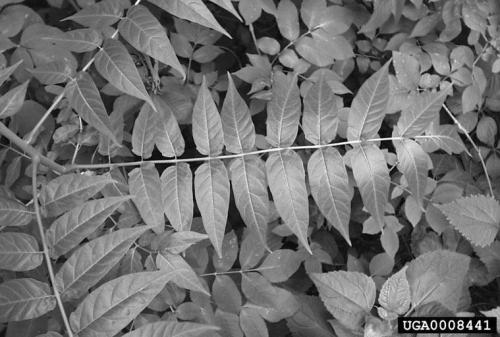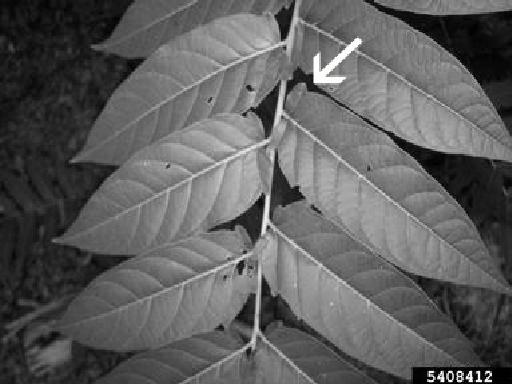Managing Tree-Of-Heaven (Ailanthus altissima)
by Dan Shaver
If you own land in Indiana, there is a very good possibility that you have non-native invasive plants to deal with. In the Fall 2010 issue of the Woodland Steward we covered "Where do I Start?! Prioritizing Invasive Plant Control." This article can be found at http://www. inwoodlands.org/where-do-i-start-prioritizing. This article was aimed at helping you figure out what you want to do with your land, what invasive species you have and how much of them you have. By knowing what you want from your land you can prioritize which invasive species are going to cause you the most trouble and where to start your control efforts.
For this article, let’s assume you want to grow native hardwood trees, but you have the invasive Tree-of- Heaven on your property. Tree-of-Heaven is a fast growing tree from Asia that vigorously sends up root sprouts forming dense colonies. Tree-of-Heaven has a large, compound leaf that is up to 3 feet long with as many as 30 leaflets, and a distinct glandular notch at the base of the leaflet.
The winged seeds are produced in abundance and help the species colonize new areas quickly (photo below).
Verticillium albo-atrum, a soil fungus, may prove to be a viable biological control for Tree-of-Heaven. One of the best cultural treatments for Tree-of-Heaven is to control the plant before you disturb the forest canopy or soil. If you are planning to build roads on your property, clear a wildlife food plot, or do any sort of timber stand improvement or timber harvest, control the Tree-of-Heaven first.
Tree-of-Heaven grows well on poor soils and capitalizes quickly on canopy gaps in the forest. Tree-of-Heaven is a serious threat to the long-term productivity of forests in the central hardwood region. There are areas in southern Indiana along the Ohio River where Tree-of-Heaven has completely taken over acres and acres of native forest and formed a monoculture of Tree-of-Heaven. If you have this species on your property, you need to control it. The best way is through an Integrated Vegetation Management (IVM) approach.
Integrated Vegetation Management (IVM) is a system where you use information on the life cycle of the plant pest and knowledge of how it interacts with the environment, combined with the most economical and effective control methods to remove the plant with the least possible hazard to people, property and the environment. For most IVM plans there are four approaches:
- Mechanical: using equipment such as mowers, chainsaws, brush axes, loppers or other tools
- Cultural: altering management techniques or incorporating native or more appropriate plant material to out-compete the unwanted vegetation.
- Biological: relying on natural predators or introduced predators to control noxious weeds or unwanted vegetation.
- Chemical: utilizing EPA-approved chemicals per product label to control unwanted vegetation.
For Tree-of-Heaven we primarily rely on Cultural and Chemical means to control the plant. Mechanical treatment can be used in limited circumstances. There are currently no Biological controls available, but there is mounting evidence that a verticillium wilt caused by Verticillium albo-atrum, a soil fungus, may prove to be a viable biological control for Tree-of-Heaven.
Cultural Control of Tree-of-Heaven
One of the best cultural treatments for Tree-of-Heaven is to control the plant before you disturb the forest canopy or soil. If you are planning to build roads on your property, clear a wildlife food plot, or do any sort of timber stand improvement or timber harvest, control the Tree-of-Heaven first. By pulling young sprouts or chemically treating this species prior to disturbance, you can drastically reduce the spread of this species following disturbance. After the disturbance follow-up to make sure you have not spread the invasive species.
Chemical Control of Tree-of-Heaven There are several chemical treatments that are effective for controlling Tree-of-Heaven. Whenever using chemicals the landowner or applicator must follow the herbicide label. The preferred treatment methods are foliar application and basal bark application. Foliar application is most effective after full canopy development to fall color (mid-June to mid-September). Unless you are treating right-of-ways, foliar application is typically a low-volume spot treatment on young trees less than head high. The herbicide label will provide recommended herbicide rates for low-volume foliar treatment. Basal bark applications typically involve wetting the lower 12-20 inches of the stem all the way around and down to the root collar. The treatment should not overflow and wet the soil around the stem. Basal bark treatments are extremely effective on any size stem and can be done most times of the year with the exception of the spring during heavy sap flow or when there is snow on the ground. Full canopy development to fall color (mid- June to mid-September) is one of the most effective times for basal bark treatment as long as the temperature is below 85° F. Mechanical Control of Tree-of-Heaven Very young seedlings can be pulled out of the soil when soil conditions are suitable. There is the potential for seedlings to re-sprout if they break off at the soil level or if they are established enough to sprout from the roots that are not pulled up. Pulling up seedlings is only recommended when other treatments are not available. It is better to pull up young seedlings than to leave them to grow for another year. Remember where they were or mark the location on a property map. Follow-up the next season to treat with herbicide or pull any re-sprouts.
For any Tree-of-Heaven besides first or second year seedlings, any sort of cutting, mowing or girdling will result in aggressive root sprouts and make the problem worse. If you have Tree-of-Heaven on your property, don’t wait to control this species. Every year you wait is one more year that tree-of-heaven will add new root sprouts, potentially reach seed bearing age (2 – 3 years), and spread vigorously with any natural or man-made disturbance. If you don’t have Tree-of-Heaven on your property, be vigilant because it will suddenly appear in small canopy gaps, along roads and in wildlife openings. Treat it as soon as you identify it.
Above - Glandular notch, near the base of the leaf, is a distinctive feature to help tell Tree-of-Heaven from Black Walnut or Sumac.



